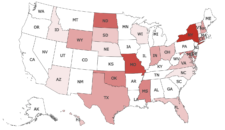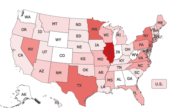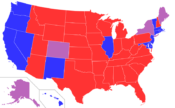 Last month provided additional confirmation that state legislatures are increasingly looking to newspaper websites rather than government sites to supplement and perhaps eventually serve as an alternative to printed newspapers as the primary medium for public notice. Bills illustrating that trend moved closer to becoming law in both Indiana and Iowa.
Last month provided additional confirmation that state legislatures are increasingly looking to newspaper websites rather than government sites to supplement and perhaps eventually serve as an alternative to printed newspapers as the primary medium for public notice. Bills illustrating that trend moved closer to becoming law in both Indiana and Iowa.
Indiana
The tenor of public notice legislation has shifted in Indiana. At the start of 2023 it was one of the two or three states that seemed most likely to abandon newspapers in favor of government websites. Yesterday the legislature approved a bill that could instead serve as a gateway to an eventual migration to newspaper websites.
News websites supplanting government sites as alternative source of notice?
 Public notice legislation introduced so far in 2024 suggests state legislatures are growing increasingly comfortable having news websites serve as an alternative source of official notice. And that comfort seems to have cooled their ardor for moving notices from newspapers to government websites.
Public notice legislation introduced so far in 2024 suggests state legislatures are growing increasingly comfortable having news websites serve as an alternative source of official notice. And that comfort seems to have cooled their ardor for moving notices from newspapers to government websites.
As of the end of last week, new legislation authorizing local news websites or newspaper websites to provide statutory notice in lieu of print had been introduced in at least six states, while bills sanctioning the move from print newspapers to government websites had been introduced in only two states — and one of them is already dead.
Few local governments in South Dakota use state portal to post public information
 Jackson County government officials don’t post public information on the internet.
Jackson County government officials don’t post public information on the internet.
The rural western South Dakota county, which serves roughly 2,800 residents spread over 1,871 square miles, doesn’t have a website.
And it doesn’t intend to, County Auditor Vicki Wilson said.
“It takes more time than we have staff,” she said.
State government offers a potential solution, but Jackson County isn’t using it. Nor are most other South Dakota counties, cities or other local governments.
It’s a website created by the Gov. Kristi Noem administration in 2021 where local governments can voluntarily upload their meeting notices, agendas and minutes, without having to manage their own website.
Newspapers battle in 2 states over right to publish notices
 Most states require newspapers to have paying subscribers to publish notices but at least a few grant that authority to free-distribution papers as well. Those requirements don’t change very often which is why it’s so unusual to have two states considering legislation this year that would allow free papers to publish notices.
Most states require newspapers to have paying subscribers to publish notices but at least a few grant that authority to free-distribution papers as well. Those requirements don’t change very often which is why it’s so unusual to have two states considering legislation this year that would allow free papers to publish notices.
The newspapers supporting the measures in both states were founded by entrepreneurs in communities where the paid-circulation newspapers have experienced multiple rounds of layoffs and cutbacks in recent years. Taking the other side of the debate are the states’ press associations, both of which oppose the bills.
Midwest press groups seek to modernize public notice laws
 (This article was corrected on April 28, 2022. See below for corrections.)
(This article was corrected on April 28, 2022. See below for corrections.)
Press associations in four midwestern states are supporting bills that would update their states’ public notice laws.
Legislatures in Minnesota and Nebraska are considering bills that would require newspapers to post all notices on their press association’s statewide public notice website. Also in Minnesota, and in Missouri, lawmakers may respond to an evolving local media environment by relaxing standards newspapers must meet to qualify to publish notices. And in South Dakota, the legislature has already passed a bill with primary elements identical to the legislation being considered in Minnesota.
State press group asks for rate increase
 The South Dakota Newspaper Association (SDNA) recently testified in support of a rate increase for public notice advertisements published in its members’ newspapers. The Aug. 23 hearing had been called by the state’s Bureau of Administration (BOA) to consider its proposal to increase those rates by approximately 4.8 percent.
The South Dakota Newspaper Association (SDNA) recently testified in support of a rate increase for public notice advertisements published in its members’ newspapers. The Aug. 23 hearing had been called by the state’s Bureau of Administration (BOA) to consider its proposal to increase those rates by approximately 4.8 percent.
Under state law, BOA sets maximum rates for public notice advertising and is required to “annually review and adjust rates to reflect changes in economic conditions.” Nonetheless, it had been five years since the agency had done that before it initiated a formal review of fees in March. The review appeared to have been spurred by a written request the department received from SDNA a few days earlier.
Bills eliminating newspaper notice introduced in 10 states
 PNRC is presently tracking about 60 different public notice bills introduced in 22 states so far in 2021. (We categorize all legislation that has any impact on public notice laws — even a minor impact — as public notice bills.)
PNRC is presently tracking about 60 different public notice bills introduced in 22 states so far in 2021. (We categorize all legislation that has any impact on public notice laws — even a minor impact — as public notice bills.)
Legislators in ten of those states have introduced bills that would move all or a significant percentage of notice from newspapers to government websites.
[See 2021 public notice legislation map]
Legislative Front Still Calm
 The first quarter has ended and the legislative front remains relatively calm. Missouri is still the only state in immediate peril of passing a major public notice bill, but even there newspapers are beginning to see light at the end of the tunnel; the two measures that have given public notice advocates in the Show Me State cause for concern didn’t budge last month.
The first quarter has ended and the legislative front remains relatively calm. Missouri is still the only state in immediate peril of passing a major public notice bill, but even there newspapers are beginning to see light at the end of the tunnel; the two measures that have given public notice advocates in the Show Me State cause for concern didn’t budge last month.
Many bad public notice bills still litter the committees of the 30+ state legislatures that haven’t adjourned yet, but none appear to have any momentum. Nevertheless, several minor bills — some that add newspaper notice and a few that reduce it — have passed so far this year. Here’s the round up.
State Legislatures Back; Public Notice Safe for Now
 The New Year again brought with it a flood of new legislation curtailing the role of newspapers as the official source of public notice. Fortunately, none of the new bills appear to be an immediate threat and several have already been killed in committee or face imminent demise.
The New Year again brought with it a flood of new legislation curtailing the role of newspapers as the official source of public notice. Fortunately, none of the new bills appear to be an immediate threat and several have already been killed in committee or face imminent demise.
Here’s an overview of some of the states that have been most active since legislatures returned to work.
South Dakotan Produces News Series From Public Notices
 Public notice isn’t a big deal to the nine South Dakota lawmakers who introduced House Bill 1167, a piece of legislation that would have moved municipal notices from newspapers to websites in many S.D. cities, if it hadn’t been killed in committee. To Brian Hunhoff (photo on left), public notice is absolutely vital.
Public notice isn’t a big deal to the nine South Dakota lawmakers who introduced House Bill 1167, a piece of legislation that would have moved municipal notices from newspapers to websites in many S.D. cities, if it hadn’t been killed in committee. To Brian Hunhoff (photo on left), public notice is absolutely vital.
Hunhoff, a contributing editor at the Yankton County Observer, has been demonstrating just how important it is with “In a Minutes Notice,” a new weekly column based on news culled from meeting minutes and legal notices published in the Observer and other newspapers in the Mount Rushmore state.
“I’ve been meaning to do this series for a long time, but could never seem to find the time,” says Hunhoff. “Then I read the (PNRC) story in the National Newspaper Association’s PubAux about all the public notice battles taking place around the country and decided it would be a good year to finally make time and get it done.”
Hunhoff has already published eight public notice-based columns (see PDFs linked below) and plans to write at least six more in the coming weeks. They include deep dives on particular subjects, like the salaries of local public officials or the frequency and length of their executive sessions. He has also reviewed meeting minutes and budgets from 12 similar-size cities and counties to learn how Yankton County and City of Yankton rank in comparison.
Hunhoff admits the project has required a great deal of research. He has spent many hours studying public notices in Observer bound volumes going back 40 years to uncover trends relating to tax-exempt properties, delinquent taxpayer lists, and highway department spending.
His commitment to the project is particularly remarkable when one considers that newspapering is no longer Hunhoff’s primary job. He was in the newspaper business full-time for 23 years until he sold the Observer in 2002. Current publishers are twin sisters Kathy Church and Kristy Wyland.
Hunhoff has been a part-time contributor to the 40-year-old weekly since selling it. His full-time job now is Yankton County Register of Deeds, where he takes pride in operating the best document archive — he calls it a “library” — in the state. He saves his public notice reporting for evenings and weekends.
Hunhoff says research for the public notice column inspires ideas for editorials. He has written four related opinion pieces for the paper since the first “In a Minutes Notice” story was published in mid-February.
His real goal, though, is to highlight the value of public notices in newspapers and help Observer readers understand their importance. He knows fewer people would read them if they were moved to the Internet — “out of sight, out of mind” he says — and that concerns him.
Hunhoff has used photos of local officials, town halls, a snowplow and a fire truck to illustrate the articles. Over 90 percent of the content is distilled from public notices. “It’s not a lot of fancy writing – just a straightforward presentation of facts gleaned from minutes and other notices,” he said. “I study numbers in a particular area until I find a newsworthy trend. Giving these stories a lead with a news hook has been the key to pulling readers in.”
“Reader response to the stories has been very good,” he added. “People seem to find them interesting and that’s the goal: To help folks understand how much important information is available in public notices in newspapers.”
